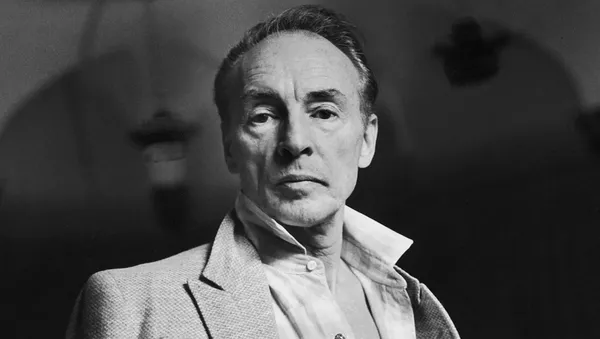 |
| In Balanchine's Classroom director Connie Hochman on George Balanchine: “Some dancers wanted every minute they could get with him - Suki Schorer, Merrill Ashley, Jacques d’Amboise.” Photo: Ernst Hass |
Connie Hochman’s In Balanchine's Classroom features interviews with Merrill Ashley, Gloria Govrin, Suki Schorer, Heather Watts, Jacques d’Amboise, and Edward Villella (“it was like working with Einstein”) on George Balanchine and archival clips of the great choreographer working with and teaching the dancers. This revealing documentary, a must-see for everyone who loves dance, gives us glimpses into the inner sanctum of the man who changed American ballet forever. Balanchine, born in Saint Petersburg, Russia, came, via Paris, to the US in 1933 and started the School of American Ballet the next year.
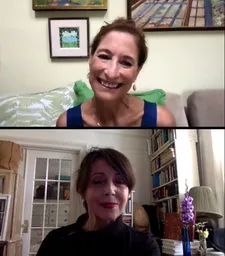 |
| Connie Hochman with Anne-Katrin Titze on meeting George Balanchine as a child: “I felt very comfortable with him, a little in awe because you felt he was running the show.” |
In 1948 the New York City Ballet was established and the “art of off-the ground” would never be the same again. The regular morning class that the master taught himself had been shrouded in mystery. Too tough for some, other members of the company became addicted to the rigor and precision it demanded. Now, almost four decades after his death, dancers open up for the first time to talk about their experiences in this unique classroom. Many of them, who became teachers and mentors themselves to pass on Balanchine’s legacy and technique, speak about how badly they had wanted his attention, how much insight he gave them, and how some of the genius unfortunately is forever lost. For Balanchine, who saw, as many dancers agree, possibilities in them that nobody else saw, the music was at the center of it all, because “the composer is the architect of time and we have to dance to it.”
From Upstate New York, Connie Hochman joined me on Zoom for an in-depth conversation on In Balanchine's Classroom
Anne-Katrin Titze: Hello!
Connie Hochman: Hi Anne-Katrin! Here we are.
AKT: Here we are! Where are you this morning?
CH: I’m in my home in Ossining, an hour north of the city in one of the Hudson River towns.
AKT: I loved about your film how obviously this was a personal quest and not in any way a run-of-the- mill documentary. We can feel the love of your subject matter, am I right?
CH: Yes, thank you! It was definitely a quest, yes. I needed to find something out, to learn something. Since I was close enough to his world, since I had these questions, then other people would be interested in the answer.
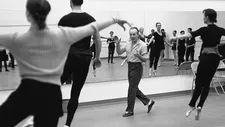 |
| George Balanchine in rehearsal: “I would say a quarter of the company took his class every day. At one point he was teaching on their day off, Mondays.” Photo: Martha Swope |
AKT: You started out at the School of American Ballet as a child. And you met Balanchine. What was your own impression of the man when you were little?
CH: You know, the school was a wonderful place for children who had this compulsion to dance. Balanchine was very present, very sweet with the children, calm, quiet, extremely focused. You felt his interest in the rehearsals and the children were very well-rehearsed for the ballet. I felt very comfortable with him, a little in awe because you felt he was running the show. You felt a special environment but it was so calm and productive, always moving along making headway, so I was pretty much in my element there, in heaven.
AKT: So it makes perfect sense that you want to return to heaven with your debut feature documentary and do some detective work. There is Balanchine the man, the dancer, the choreographer, but an equal amount of focus is on the teaching. His mysterious morning class, the forbidden room where the mystery of his legacy came to be.
CH: I went through the school, the classes were extremely hard. When my friends got into the company, I did not get into New York City Ballet, I danced with Pennsylvania Ballet, but I’ve been close to my friends and I wanted to know about this class that Balanchine taught every morning. And nobody would tell me about it.
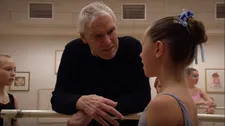 |
| Jacques d'Amboise talks to a young student In Balanchine's Classroom |
AKT: It sounds like Fight Club.
CH: They just wanted to move on and then I kept getting these hints along the way that something happened in that class that was important. People weren’t allowed to watch the class. You were allowed to watch rehearsals, as you can see in photographs. Suki Schorer was one of my teachers at School of American Ballet and when Pennsylvania Ballet came to New York she came to see me in a Balanchine ballet where I did a solo and she came backstage. I mean, I had gone through the school all the way from age 10 to 18, she came backstage and said it was lovely, “but you don’t get it.”
AKT: Okay!
CH: It’s about opposition! I kept getting those hints that there’s something missing. That’s what I was compelled to find out. What did he actually teach in the class that his dancers knew?
AKT: Your film lets us in on some of his instructions. “Your hands like baby,” for example, or “like a piece of Kleenex.” He uses cooking metaphors like “scraping the bowl with your foot.”
CH: Yeah, I did about a hundred interviews. That ran through all the interviews how he set their imaginations going. At first the dancers didn’t understand; they were not easy metaphors.
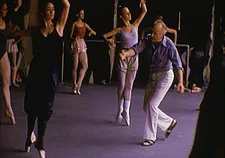 |
| Connie Hochman on George Balanchine: “He was, I think, pushing the envelope with these specific bodies. And with each generation they could do more and more.” |
AKT: Then there were the repetitions. How many, how fast? And the sentence: “What are you saving it for?” I think it is Edward Villella who says that he couldn’t attend the class and at the same time be performing at night.
CH: You know, most of the company didn’t take his class. When the company was 90, close to 100, I would say a quarter of the company took his class every day. At one point he was teaching on their day off, Mondays. Some dancers wanted every minute they could get with him - Suki Schorer, Merrill Ashley, Jacques d’Amboise. I’m fortunate that some of the important characters in the movie were those very loyal ones. If you only dropped into his class one or two days a week, you couldn’t do it. But if you took it every single day, like Olympic training, your body craved his class.
AKT: Near the start of the film you make the point that there was no real ballet training in America before Balanchine. Someone says it was “like being a pupil of Einstein.”
CH: Balanchine had such an incredible eye and he had been a dancer and he came from Europe.
AKT: Ballets Russes and Diaghilev, yes.
CH: And he saw these bodies that maybe were not that well-trained, but were healthy and able and he had all these ideas. He was, I think, pushing the envelope with these specific bodies. And with each generation they could do more and more. I feel I could not have done his class, I would have had trouble. I was pretty tough but to me those dancers that stuck with him are my heroes because they went through a lot physically and psychologically. But they had such grit and hunger and aspiration.
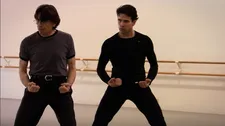 |
| Edward Villella coaching Carlos Guerra In Balanchine's Classroom |
AKT: It’s very interesting how you continue on from the myth of Balanchine’s classroom and show some of his dancers themselves teaching. Teaching someone like Tiler Peck. I just recently watched Steven Cantor’s film on her. I don’t know if you’ve seen it? He sent me the link in the context of our conversation on Twyla Moves.
CH: I saw it.
AKT: All of Balanchine’s pupils, though, talk of a certain lack as far as their own teaching is concerned. It’s like an erosion, I thought?
CH: Yes, this is very hard to talk about. Because it’s bittersweet. The dancers today are so spectacular and they are so hungry and open to what the Balanchine dancers are teaching them. They hang on every word. But the Balanchine dancers today are not Balanchine. They are each a ray of Balanchine. To me, all their voices together capture Balanchine. This could be debated, but to me each one is an interpretation. In a way it’s inevitable that something is lost. And yet the dancers today have unlimited potential and are very smart, so something also is growing. Balanchine was very optimistic, I feel.
AKT: Jacques says that he allowed all the dancers to add their own spice. That same spice then, of course, goes into the individuals’ teaching. So we get a different menu, to stay with the cooking metaphor.
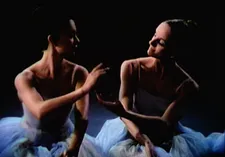 |
| George Balanchine's Serenade, New York City Ballet |
CH: Absolutely.
AKT: You also have footage of Balanchine talking, clips from some of the performances. Was the New York Public Library for the Performing Arts one of your go-to places for the footage?
CH: Yes, my husband Mark and I spent one whole summer, 2013 or 2014, where we almost camped out and lived there. And we did discover some amazing footage there.
AKT: It’s a great place to find hidden treasures.
CH: But one of the main resources we found another route.
AKT: A private one?
CH: Yes, it was somebody who had been able, had permission to film. Eventually I earned the trust of that person. Very indebted - it would have been a very different film without that footage.
AKT: A short while ago I read the obituary of Patricia Wilde in The New York Times. Was she one of the people you interviewed? I don’t remember hearing her talk in the film.
CH: She is not in the film via interview, but she is seen dancing in the film in a few sections. Patricia Wilde was actually one of my very first interviews. She was one of the very loyal people who took his class. She actually did three interviews and we filmed her teaching. She’s a very special dancer and very brilliant person and teacher.
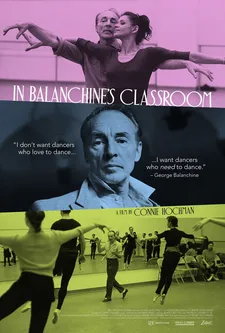 |
| In Balanchine's Classroom poster |
AKT: Those interviews that didn’t make it into the movie, will they be available in some shape or form?
CH: I’m so glad you ask, because we have started work on the archive, the IBC digital archive and it will have the interviews in full, unedited.
AKT: Great!
CH: The vérité footage, we want to have that also. We have been in touch with the George Balanchine Trust and they are interested in this project of the archive.
AKT: That’s wonderful, because it is obvious that there is so much more. Today, even when people don’t immediately have recognition of the name Balanchine anymore, there are traces leading to him. In my own teaching experience, I often get blank stares when I speak of the authors of German Romanticism. Only when I bring up E.T.A. Hoffmann and mention The Nutcracker, immediately, there is some recognition. And what these students have in their heads are images from The Balanchine ballet. Your film is very much about the transmission in the act of teaching. Are you a teacher yourself?
CH: I did teach ballet for many many years in Westchester after I stopped dancing and we moved back to New York. One more thing about his teaching. He taught technique on a very high level, it was so detailed that unless you get deep enough it could get misconstrued, the precision, as Jacques calls it, the “geometry.” Classical ballet is the foundation but what really really interested him besides the music, which was the whole reason, was the individuality of his dancers. And to me that was the most incredible part of his teaching, how he would key into individuals and wanted to take something further that he saw in them. How much he loved the quirkiness or idiosyncrasies of people.
AKT: That’s the magic of Balanchine and of great teaching in general. I think you perfectly summed it up. Please stay in touch about the archive!
CH: We hope to launch a website very soon that will announce the movie and also introduce the new project. Thank you! It was a pleasure to meet you.
In Balanchine's Classroom opens at Film Forum in New York on September 17.





















